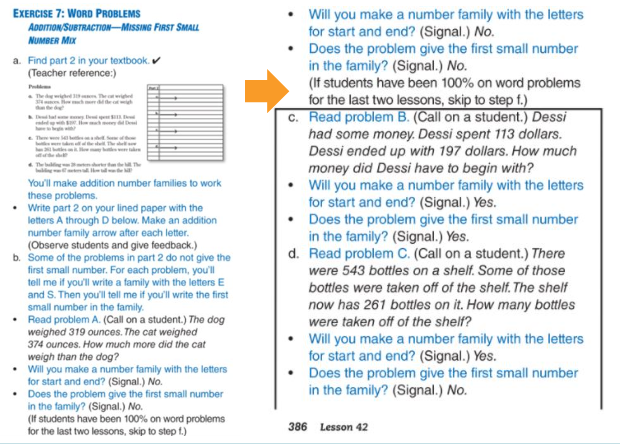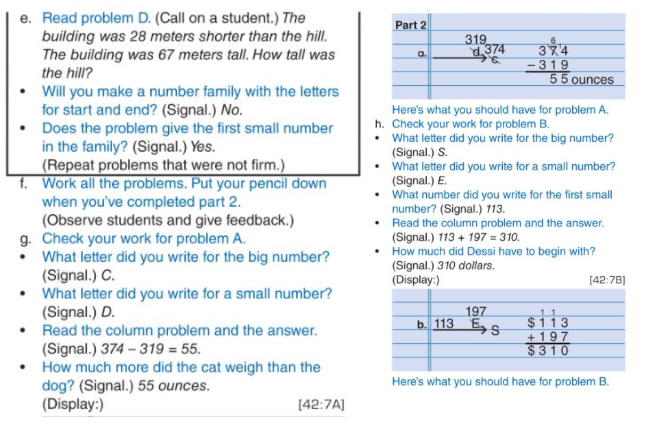Teach Connecting Math Concepts E (5)
-
Module introduction5 Topics
-
Overview25 Topics|3 Tests
-
Cover
-
Lesson objective
-
Opening the lesson
-
Direct Instruction overview
-
CMC overview
-
Teacher’s role in motivation
-
Affirmations
-
CMC E materials
-
Time requirements
-
Placement testing
-
Check Your Understanding
-
Grouping, seating, STAR, transitions
-
Routines for transitions
-
Script features
-
Script with brackets
-
Abbreviated scripts
-
Call on individual students
-
Check Your Understanding
-
RMSE LA K-Individual Turns
-
Board work
-
Lined-paper icons
-
Maths learning behaviours
-
Test Your Understanding
-
Review
-
Lesson completed!
-
Cover
-
Connecting CMC to Oz-e-maths15 Topics|2 Tests
-
Addition number families22 Topics|2 Tests
-
Cover
-
Lesson objective
-
Opening the lesson
-
Auditory signal
-
Auditory signal
-
Number families
-
Corrections and repeat until firm
-
Active monitoring
-
Active monitoring
-
New direction
-
Number family computation
-
Corrections spoken and written
-
Comparison word problems
-
Check Your Understanding
-
Sequence word problems
-
Abbreviated skip boxes
-
Sequence word problems with abbreviated skip box
-
Classification word problems
-
Corrections for number families
-
Test Your Understanding
-
Review
-
Lesson completed!
-
Cover
-
Multiplication number families and facts21 Topics|2 Tests
-
Cover
-
Lesson objective
-
Opening the lesson
-
Multiplication families
-
Point-touch signal
-
Point-touch signal
-
Multiplication family: word problems overview
-
Multiplication family: times word problems
-
Multiplication family: each/every word problems
-
Multiplication family: unit measurement/fact word problems
-
Check Your Understanding
-
Corrections for multiplication number families
-
The tick
-
Facts explained
-
Multiplying by 9
-
Droning and corrections
-
New fact families
-
Corrections for facts
-
Test Your Understanding
-
Review
-
Lesson completed!
-
Cover
-
Fractions and whole numbers17 Topics|2 Tests
-
Cover
-
Lesson objective
-
Opening the lesson
-
Basic fraction analysis explained
-
Basic fraction analysis
-
Fractions lesson thirty-one
-
Fractions lesson forty-two
-
Fraction multiplication
-
Equivalent fractions
-
Corrections
-
Whole numbers
-
Script success
-
Check Your Understanding
-
Test Your Understanding
-
Lesson practice
-
Review
-
Lesson completed!
-
Cover
-
Decimal, Per cent and Geometry18 Topics|2 Tests
-
Cover
-
Lesson Objective
-
Opening the Lesson
-
Decimal and Per cent Overview
-
Decimals
-
Per cents
-
Corrections
-
Geometry Overview
-
Perimeter – Area
-
Angles
-
Supplementary and Vertical Angles
-
Protractors
-
Call on Individual Students
-
Check Your Understanding
-
Test Your Understanding
-
Video: Demonstration
-
Review
-
Lesson Completed!
-
Cover
-
Column subtraction, multiplication and division21 Topics|2 Tests
-
Cover
-
Lesson objective
-
Opening the lesson
-
Auditory signal
-
Auditory signal
-
Column subtraction types
-
Column subtraction
-
Column subtraction doubling
-
Point-touch signal
-
Point – Touch Signal
-
Column multiplication overview
-
Multiplying 2-digit by 1-digit numbers
-
Multiplying by tens
-
Corrections
-
Division
-
Remainders
-
Interior remainders
-
Check Your Understanding
-
Test Your Understanding
-
Review
-
Lesson completed!
-
Cover
-
Rounding, estimation, coefficients, inverse operations and mixed-number computations17 Topics|2 Tests
-
Cover
-
Lesson objective
-
Opening the lesson
-
Rounding and estimation
-
Rounding
-
Rounding to tens, hundreds and thousands
-
Coefficients
-
Inverse operations
-
Corrections
-
Mixed number computations
-
Adding – subtracting
-
Multiplying mixed numbers with whole numbers
-
Observe students and give feedback
-
Check Your Understanding
-
Test Your Understanding
-
Review
-
Lesson completed!
-
Cover
-
Coordinate system and functions, ratio word problems and prime factors19 Topics|2 Tests
-
Cover
-
Lesson objective
-
Opening the lesson
-
Point-touch signal
-
Point – Touch Signal
-
Coordinate systems
-
Functions
-
Fractional coefficients
-
Ratio word problems
-
Each/every
-
Check Your Understanding
-
Fraction wording
-
Prime factors
-
Multiples
-
Prime numbers
-
Composite numbers
-
Test Your Understanding
-
Review
-
Lesson completed!
-
Cover
-
Motivating students and independent work20 Topics|2 Tests
-
Cover
-
Lesson objective
-
Opening the lesson
-
Basis of student motivation
-
The importance of monitoring responses
-
Providing affirmations
-
Affirmations
-
Communicate in a positive manner
-
Specific positive feedback
-
Using specific positive praise
-
Independent work
-
Independent work expectations
-
Work checks
-
Work checks for independent work
-
Conducting work checks
-
Work-checks
-
Check Your Understanding
-
Test Your Understanding
-
Review
-
Lesson completed!
-
Cover
-
Mastery tests24 Topics|2 Tests
-
Cover
-
Lesson objective
-
Opening the lesson
-
Conducting mastery tests
-
Mastery tests
-
Using mastery test information
-
Mastery test criterion
-
Providing remedies
-
Determining who needs remediation and retesting
-
Mastery tests on SPT
-
Inputting Data
-
Cumulative tests
-
Flight path concept
-
Check Your Understanding
-
Expected lesson pacing
-
Lesson progress on SPT
-
Pacing of instruction
-
Effective transitions
-
Lesson pacing and transitions
-
Teaching routines
-
Effective routines
-
Test Your Understanding
-
Review
-
Lesson completed!
-
Cover
-
Bringing it all together28 Topics|2 Tests
-
Cover
-
Lesson objective
-
Opening the lesson
-
Auditory signal
-
Auditory signal
-
Corrections and repeat until firm
-
Correction tips
-
Lesson 42, exercise 1
-
Point-touch signal
-
Point – Touch Signal
-
Lesson 42, exercise 2
-
Lesson 42, exercise 3
-
Abbreviated skip boxes
-
Lesson 42, exercise 4
-
Lesson 42, exercise 5
-
Lesson 42, exercise 6 with textbook practice
-
Corrections spoken and written
-
Lined-paper icons
-
Lesson 42, exercise 7
-
Lesson 42, exercise 8
-
Lesson 42, exercise 9
-
Lesson 42, exercise 10
-
Script success
-
Check Your Understanding
-
Test Your Understanding
-
Lesson practice
-
Review
-
Lesson completed!
-
Cover
-
Module evaluation survey1 Topic
Participants 533
Abbreviated skip boxes
ddewell@goodtogreatschools.org.au August 7, 2023

Abbreviated skip boxes
CMC E has places in the script that state a criterion followed by a skip box. All skip boxes work the same way.
The teacher direction specifies a criterion for student performance. If the teacher is confident that the students have met that criterion and are confident students do not need the additional practice, then they skip the part of the presentation that is boxed and start at the step that is specified in the directions.


Three basic criteria
Three basic criteria are followed:
1. perfect performance for that exercise to that point
2. perfect performance for all the exercises of that type in the last two lessons, including that exercise to that point
3. teacher confidence that the students are firm and have mastered that exercise.
Sometimes problems in the workbook and textbook are boxed. The box indicates that the problems may be skipped. Some teachers like to assign skipped problems for extra-credit independent work.
The teacher needs to be conscientious about not skipping steps when the group does not meet the criteria. An average class usually has several students who benefit greatly from the additional practice on most exercises. Some classes will not meet the criteria for any of the skip boxes. Some class will meet the criterion for ten to fifteen per cent of the skip boxes. Only very high performing classes will meet the criterion for more than thirty per cent of the skip boxes.
The skip boxes are never used to make up for lesson progress. The result of missing practice can cause students’ performance to slow down in later lessons due to lack of fluency.

